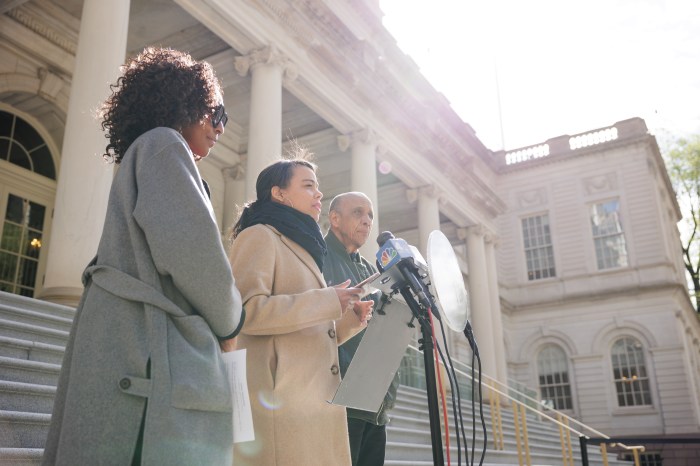By Amy Chin
In the days and weeks after 9/11, like all our Downtown neighbors, the New York Chinese Cultural Center was not sure whether or when we could re-open and resume our programs. Now, two and half years later, our dance, art and language classes are again filled with children and adults from the tri-state area; N.Y.C.C.C.’s Chinese Folk Dance Company performs non-stop locally and nationally; and our recent performances at the Winter Garden and at New York University’s Skirball Center for the Performing Arts attracted enthusiastic audiences of thousands. It is a stark contrast to those first few days and weeks when we and the rest of Chinatown essentially disappeared from the radar.
Not until the dust settled did the rest of the city begin to notice our community’s devastation in the now absent shadows of the World Trade Center. It has been a long road back and Chinatown is still on the earliest stretch of that journey. Aside from limited resources even pre-9/11, the community’s recovery was further slowed by the SARS hysteria which again frightened away new visitors and old friends alike. As Chinatown’s traditional economic base of restaurants, factories and shops continued to erode, residents and community leaders like myself anxiously scanned the horizon for signs of a brighter future.
Throughout countless discussions, one vision surfaced repeatedly – a world class cultural and performing arts center in New York’s Chinatown to house and showcase the community’s cultural riches and to connect Chinatown to the rest of New York. This is an idea that has been floating around for decades, but it took a national atrocity to help us focus on big dreams for the future of our community.
Few will dispute New York’s standing as an arts capital. Recognizing the vital role of the arts in enlivening surrounding neighborhoods and spurring economic growth, planners charged with re-envisioning the World Trade Center site incorporated a major complex of cultural spaces in the master plan. In Downtown Brooklyn, the creation of cultural spaces is a cornerstone of the neighborhood’s revitalization strategy. Chinatown needs to be a part of this “cultural revolution” and the Lower Manhattan Development Corporation’s recent funding of a feasibility study is an important first step in this direction.
New York’s Chinatown used to be THE Chinatown. As a young girl growing up in the Bronx, I made weekly pilgrimages to Chinatown with my parents to stock up on Chinese groceries, have a real Chinese meal, and catch up on the news. Today, as the Chinese-American population grows, vest-pocket Chinatowns are springing up across the nation. “Weekly pilgrimages” are less necessary and the primacy of New York’s Chinatown as a destination is diminishing.
As we plan for Chinatown’s future, we must consider what will make it unique and different from other Chinatowns. What are the assets that cannot be easily replicated elsewhere and will continue to draw new and repeat visitors? One asset is high-quality Chinese cultural arts programs. Nowhere else outside of Asia is there the high concentration of quality Chinese artists and arts programs found here in New York’s Chinatown – HT Chen Dance Company, Asian American Arts Centre, Museum of Chinese in the Americas, Four Seas Players, Yangtze Repertory Theater, Fu Kai Cantonese Opera, Music From China, bamboo animal craftspeople, and countless others.
A cultural and performing arts center will stabilize and reinvigorate the local artistic community. Also, it will be host to cultural activities of all types and be open to artists outside of Chinatown as well. This will link Chinatown’s artistic wealth with the broader cultural life of Downtown and to cultural development in the rest of New York City. It will ensure that Chinatown will not remain in the cultural shadows of this city. A cultural center will draw more people to Chinatown who maybe do not know to come here or wouldn’t specifically think to come, but because they came for a performance, class, rehearsal, art exhibit, or film end up in this great place to shop and eat. For Chinatown residents, the center would be a welcoming, communal gathering place where we can celebrate our culture and heritage. It would also be a home for organizations like my own which are endangered by high rents and lack of adequate space.
This year, my organization celebrates its 30th year in Chinatown. With a budget just under $1 million and over 3,000 classes and performances each year, we are the largest performing arts organization in the largest Chinatown in the western hemisphere – a Chinatown with 150 years of history. This history implies a high level of stability, but just below the surface is a fragile foundation. Over the years, N.Y.C.C.C. has borrowed, donated, sublet, shared and leased a variety of spaces. At our current location, we face a future that is as uncertain as Chinatown’s. Nearing the end of a ten-year lease, we are threatened with the doubling of our rent and soon may no longer be able to afford to stay in our home community.
Our situation is not unique. In recent months, we have seen the oldest store in Chinatown close its doors. Other cultural groups in Chinatown face similar challenges. Some are on month-to-month leases. Others operate from their living rooms. All are squeezed into inadequate and cramped spaces that do not do justice to the quality of the artistry produced. When performance time comes for N.Y.C.C.C., we must leave Chinatown for the likes of the Tribeca Performing Arts Center, the Winter Garden, or Skirball Center because there is no theater facility here with the necessary stage and audience capacity for our productions. It is time we bring it home.
The arts are powerful. They inspire us, unite us, and sustain us as individuals and as a community. Few initiatives in Chinatown’s history have drawn such widespread support as the dream of a cultural and performing arts center. I am hoping that this dream can become a reality – our collective future hinges on it.
Amy Chin is executive director of the New York Chinese Cultural Center.
Reader Services


















